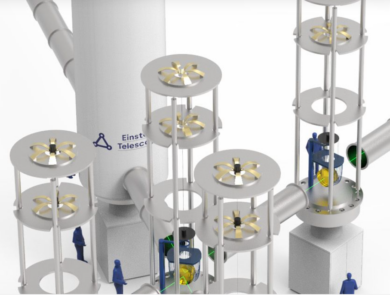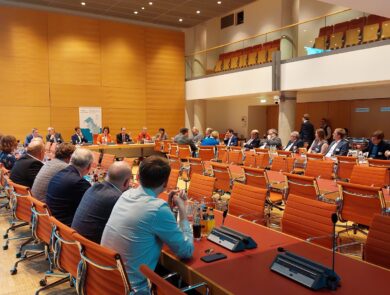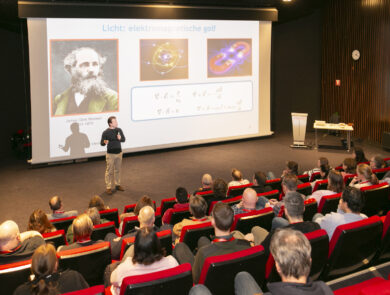First grant from R&D scheme Einstein Telescope for high-tech companies
A Dutch consortium of the companies Demcon kryoz from Enschede and Cooll from Hengelo and the University of Twente will receive a grant to develop an advanced cooling system for the Einstein Telescope.
This huge observatory for gravitational waves may be built 250 to 300 meters below the Earth’s surface in the Dutch-Belgian-German border area to allow undisturbed measurements. Vibration-free cooling to very low temperatures is necessary to detect the very weak signals from the universe. The three parties are using their fundamental knowledge and industrial expertise of vibration-free cooling to make gravity wave measurements much more accurate. To this end, they will receive 2.6 million euros over a three-year period from the R&D scheme for the Einstein Telescope, funded by the Dutch National Growth Fund.
Gravitational waves resulting from extreme events in the universe, such as the merging of two black holes, were predicted by the great physicist Albert Einstein. A century later, in 2015, they were observed for the first time by two American observatories. In Europe, work is now underway on a new, extremely sensitive detector, the Einstein Telescope. This will allow researchers to make many more observations of “ripples in the space-time fabric. In this way, they want to better understand the birth process of black holes and gain more insight into the nature of the universe immediately after the Big Bang. They can also use the new underground “telescope” to further test predictions of Einstein’s theory of relativity.
To encourage innovation and accelerated development of new technologies for the Einstein Telescope, the ET valorization program was launched in the fall of 2023. Part of this program is an R&D scheme for high-tech companies.
Dutch Minister Dijkgraaf of Education, Culture and Science: “Fantastic to see this consortium getting to work to develop the technology for the Einstein Telescope. This collaboration between knowledge institutions and companies shows how joining forces can lead to groundbreaking research and innovation. The Einstein Telescope promises not only new scientific discoveries, but also economic growth and jobs. Although we are not yet sure where the telescope will soon be located, this collaboration is an important investment in our country and international science.”
Three-stage cooling system
For the Einstein Telescope, the three parties joined forces last year when the first call of the R&D scheme was opened. It was recently announced that their proposal was honored. The Twente consortium will receive €2.6 million for a period of three years to make the technology suitable for the Einstein Telescope. To this end, they will develop a three-stage cooling system. That works with three different coolants, neon, hydrogen and helium, to go from -195 °C (78K) (the temperature reached with liquid nitrogen, which starts the cooling process) to the final and most difficult step to -263 °C (10K). They will eventually build three of them, one for research at the UT in Enschede and two for the ETpathfinder, the R&D lab for gravity wave detectors, in Maastricht.
Scaling up
Pieter Lerou, managing director of Demcon kryoz, was ultimately responsible for the proposal: “The principle for vibration-free cooling is well known and we have made it work on an industrial scale. But that was with a microcooler, whereas the coolers for the Einstein Telescope work with an immense compressor and much higher power. This scale-up still requires a lot of fundamental research. For this, we will use our knowledge of cryogenic technology and our experience in designing, modeling and building high-tech cooling systems. We also bring in our expertise of systems engineering. We ensure that all the knowledge and expertise and all the necessary components come together and that as the end result a reliable working system is delivered on schedule and within budget. This is certainly necessary, because with the outcome of our project we contribute to the bid book for the Dutch-Belgian-German location of the Einstein Telescope.”
Milestone
Milestone
Program Manager Jorg van der Meij (LIOF, on behalf of the Dutch Regional Development Agencies): “Today we celebrate a milestone in the Einstein Telescope valorization program, where a consortium of visionary companies and a leading knowledge institution have received the first R&D grant. Their innovative plans around vibration-free cooling not only strengthen the candidacy for the Einstein Telescope but are also promising for other sectors and applications. Think, for example, of aerospace engineering or the semiconductor industry. Vibration-free cooling will also become important in electric flying.”
Dutch-Belgian-German initiative
The Einstein Telescope is to become part of the major European research infrastructure. There are now two initiatives for an underground site. Besides Sardinia, it is the border area of the Netherlands, Belgium and Germany. That is suitable for an underground observatory because the soft topsoil blocks vibrations from human activity on the surface, so measurements will not be disturbed. The location of the Einstein Telescope will be decided in 2025/2026 and construction should start around 2030. A large number of universities and scientific institutions from the Netherlands, Belgium and Germany are now working on a joint application.


